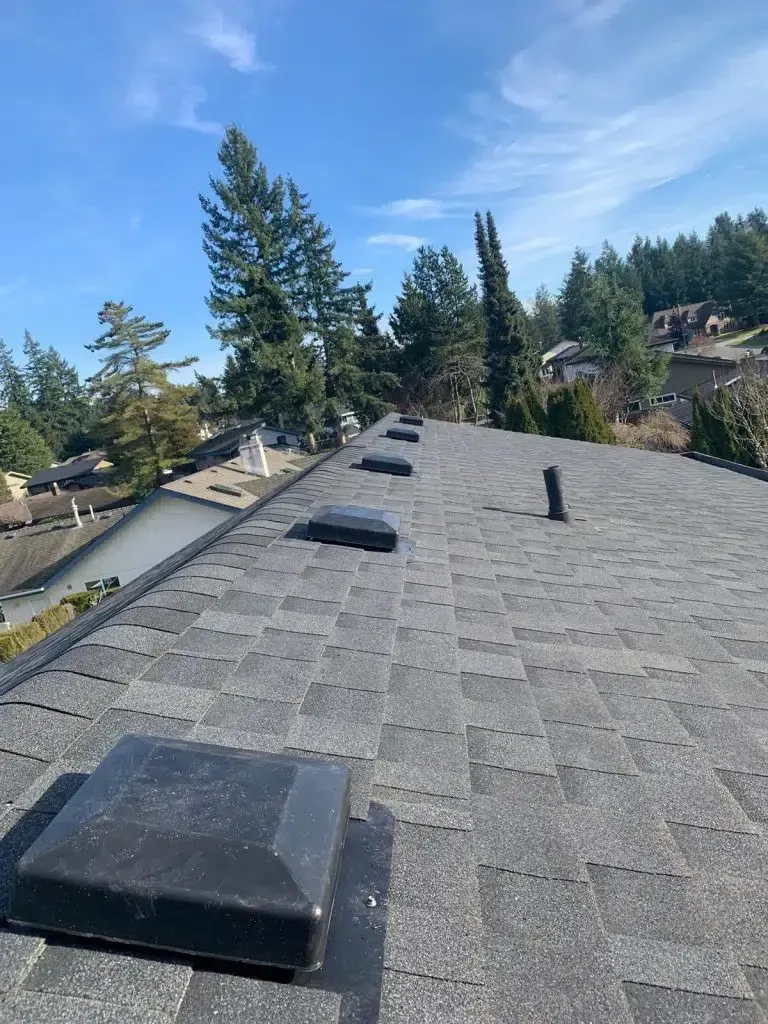How Rain and Snow Shape Burnaby Roofs All Year—A Roofer’s Deep-Dive
The view from a Burnaby rooftop can fool you. On a clear July morning, the Coast Mountains glow steel-blue in the distance, gulls circle Brentwood’s glass towers, and every cedar shake seems baked bone-dry. Twelve weeks later those same shakes might be spongy, dripping, and twice their weight. That whiplash—sun to sideways rain, drizzle to wet snow, thaw to another atmospheric river—writes the life story of every roof in our city. I’m Harman Singh, lead installer at Paragon Roofing BC, and after fifteen Burnaby winters I’ve seen what Pacific moisture does to asphalt granules, membrane seams, metal clips, and the trust homeowners place in them. Buckle in; we’re going long and granular—minimum two thousand words of weather-powered roof talk with all the peaks and valleys of a real-world year.
1. Burnaby’s Moisture Math: Numbers That Matter
“If you don’t measure it, you misjudge it.”
Burnaby isn’t merely “rainy.” It’s a certified rainforest suburb clocking roughly 2,350 mm of combined rain and melted snow per year —almost eight feet of water pelting the average detached roof. Month-to-month swings are jaw-dropping:
- November: about 247 mm of rain, or 10 inches.
- July: a miserly 33 mm —barely enough to dampen the dust.
Snow? Rare but not trivial. Historical charts peg January’s 31-day rolling average at 3.6 inches (≈9 cm), typically peaking the first week of the year. The key takeaway is volatility, not just totals. One fortnight can dump more water than the preceding two months combined—and that roller-coaster humidity wreaks mechanical, chemical, and even biological havoc.
2. The Physics of Water on Roof Assemblies
Water weighs. A cubic metre tips the scales at one tonne. When a 2:12-pitch torch-on system flatlines its drains with pine needles, a two-hour deluge adds literal tonnes of load. Hydrostatic pressure then pushes laterally, probing seams, fish-mouths, and punctures.
Snow behaves differently. Fresh powder insulates; old, refrozen crusts do not. When coastal flurries ride a warm frontal system, the snow temperature hovers around zero, sucking heat from attic air, melting just enough to refreeze at eave metal—your textbook ice dam. The next morning a chinook gust nudges everything back above 5 °C, liquid water races beneath the dam, and soffit plywood drinks deep.
Meanwhile, vapor diffuses upward, meeting a chilly deck. Condensation forms on the underside of OSB; black mould follows. Thus rain, snow, and the vapor cycle form a three-headed hydra gnawing at Burnaby roofs 365 days a year.
3. Material-by-Material Carnage (and Survival)
3.1 Asphalt Shingles
Our micro-monsoons hammer granules loose, leaving UV-sensitive asphalt exposed. In summer those bare patches hit 70 °C under direct sun, accelerating oxidative brittleness. Winter then flexes the shingle; cracks spider out; wind creates lift points; water intrudes.
3.2 Architectural Metal
Rain itself is no enemy; it’s the acidic rain plus dissimilar-metal runoff from antennas and solar racks. Galvalume’s protective layer can micro-pit, leading to cosmetic staining that Burnaby strata councils love to photograph in red ink. Snow load can “oil can” panels between clips if panel spacing ignores expansion math.
3.3 Torch-On and SBS Membranes
These low-slope heroes hate ponding. Our codes allow 1/50 slope, yet clogged scuppers negate it. UV + standing water = membrane blisters. When freeze-thaw hits those bubbles, they rupture like tiny water balloons.
3.4 Cedar Shakes
Rain doesn’t just wet cedar; it feeds Gloeocapsa magma algae and Coniophora puteana (brown-rot fungus). Snow blankets slow the drying curve: shakes remain above fibre saturation longer, inviting rot.
3.5 Concrete Tiles
Porous, absorbent, heavy. Saturated tiles during a cold snap freeze, expand, and spall. One Burnaby client counted 41 shattered tiles after the December 2022 polar outflow.
4. The Seasonal Gauntlet
Winter (Late Nov – Feb)
- Storm Intensity: Atmospheric rivers—sub-tropical plumes unloading 100 mm in 36 hours.
- Threats: Ice dams, membrane lifting at parapets, skylight flange leaks, thaw-freeze cycles corking drains with refrozen slush.
- Pro-Tip: Vacuum every internal drain the day before Environment Canada’s rainfall warning. I charge less than the insurance deductible.
Spring (Mar – May)
- Storm Intensity: Showery, gusty, temperature zig-zags.
- Threats: Expansion gaps open in sheathing; nail pops appear. Moss begins its verdant invasion.
- Pro-Tip: Hit asphalt valleys with zinc strips right after the cherry blossoms fall—the runoff will stunt moss early.
Summer (Jun – Aug)
- Storm Intensity: Low rainfall, high UV, occasional hail.
- Threats: Thermal shock—shingles bake, then a freak thunder shower slams them cool, stressing tabs. Metal fasteners back out in daily expansion cycles.
- Pro-Tip: Schedule coating or paint refresh in late August when substrates are bone-dry but before autumn dew.
Fall (Sep – Mid Nov)
- Storm Intensity: Steady recharge of the cloud factories; first wet Pacific bombs arrive.
- Threats: Leaf clogging, gutter overload, premature snow on warm roof surfaces that melts from below.
- Pro-Tip: I run infrared drone scans every October. You’d be amazed how many hidden deck leaks glow like neon on a 12 °C evening.
5. Micro-Climates Within Burnaby
Burnaby Mountain catches heavier fog and orographic rainfall—Simon Fraser University’s roofs age faster than those by Metrotown. South Slope homes, by contrast, bask in marginally better sun corridors and stronger winds that dry roofing faster. I adjust shingle nailing patterns (six-nail high-wind spec) east of Royal Oak because of the Burrard Inlet pressure channel. Local knowledge beats any generic manufacturer install guide.
6. Maintenance Playbook—Roofer’s Edition
- Quarterly Camera Sweep – A 5-minute drone flight logs ridge, valley, and chimney flashings. Compare frames season-to-season; you’ll spot granular loss trends long before they hit your living-room ceiling.
- Autumn Hydro-Flush – We jet-wash interior drains and perimeter scuppers with 3,000 psi spinning nozzles. Yes, roofs get baths.
- Snow-Load Triage – If snow depth exceeds 15 cm, we stage soft-rake removal on vulnerable low-slope sections. The goal isn’t bare membrane; it’s to create melt channels.
- Fastener Torque Audit – Gypsum-deck commercial roofs lose screw tension yearly. We re-torque to 275 in-lbs each spring.
- Moss Neutralization – Apply sodium percarbonate powder along hips; a gentle rain activates it into hydrogen peroxide foam—moss turns straw-yellow in 48 hours.
- Ventilation Balancing – Rain saturates insulation only when warm interior air meets cold sheathing. Boosting soffit intake and adding baffled ridge vents drop deck humidity 10–15 %, proven by our Testo hygrometers.
7. Case Files: Real Roofs, Real Lessons
Case A: Brentwood Tower Penthouse—Metal Clip Fail
Timeline:
Installed 2017, leaked November 2023.
Cause:
Stainless clips on aluminum standing-seam panels were under-spaced; thermal cycling sheared two clips. Storm water found the breached seam during a 230 mm November.
Fix:
Added floating clips every 400 mm; injected butyl sealant; annual torque checks scheduled.
Case B: Deer Lake Heritage Home—Cedar Shake Rot
Timeline:
Installed 2005, major rot revealed March 2024.
Cause:
North-facing pitch never sees summer sun; shakes stayed above 20 % moisture content. Fungal decay ate 40 % of butt ends.
Fix:
Hot-dip treated #1-prime shakes installed; copper ridge strip added; homeowner agreed to bi-annual spray treatment.
Case C: Lougheed Mall—SBS Ponding Catastrophe
Timeline:
New torched cap 2022. By January 2025 ponding depth hit 32 mm. Freeze event cracked blisters.
Fix:
Installed tapered ISO overlay adding 2 % slope; retrofitted three extra 4-inch drains; polyester-reinforced cap sheet torched in June.
8. Forward-Proofing Burnaby Roofs
- Climate-Resilient Materials: Malarkey rubberized shingles flex through freeze-thaw; Kynar-coated steel resists acidic rain streaks.
- Integrated Storm Management: Pair scuppers with splash boxes that feed rain gardens; lighten municipal pipes and earn green-building credits.
- Smart Monitoring: IoT leak sensors beneath deck alert your phone at the first drip—cheap insurance in a city where November rains challenge gravity itself.
- Solar-Ready Flashings: Rain and snow wash dust off panels, boosting winter efficiency—but only if your stanchions are triple-flashed and stainless-lagged.
9. My Roofer’s Bottom Line
Rain and snow in Burnaby aren’t random nuisances; they’re persistent sculptors carving grooves in every roofing material, joint, and expectation. Treat them with respect, data, and proactive craft, and your roof can shrug off a decade of deluges. Neglect them, and the next pineapple-express storm will turn your attic into a rainforest exhibit.
At Paragon Roofing BC, I rest easier when clients understand the full annual choreography: November’s biblical soak, January’s freeze-thaw mind game, March’s moss awakening, July’s UV scorch, October’s leaf tsunami. Master those rhythms and you master longevity.
So, next time you admire a buttery sunset over Burnaby Mountain, spare a glance upward. That silent patchwork of shingles or panels is fighting a year-round roof care in Burnaby battle against water in all its mischievous forms. And trust me—I’ll be up there, harness clipped, coffee in hand, making sure it keeps winning.



